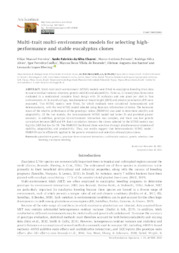Multi-trait multi-environment models for selecting high-performance and stable eucalyptus clones.
Multi-trait multi-environment models for selecting high-performance and stable eucalyptus clones.
Author(s): FERREIRA, F. M.; CHAVES, S. F. da S.; PEIXOTO, M. A.; ALVES, R. S.; COELHO, I. F.; RESENDE, M. D. V. de; SANTOS, G. A. dos; BHERING, L. L.
Summary: Multi-trait multi-environment (MTME) models were fitted to eucalyptus breeding trials data to assess residual variance structure, genetic stability and adaptability. To do so, 215 eucalyptus clones were evaluated in a randomized complete block design with 30 replicates and one plant per plot in four environments. At 36 months of age, tree diameter at breast height (DBH) and pilodyn penetration (PP) were measured. Two MTME models were fitted, for which residuals were considered homoscedastic and heteroscedastic, with the best MTME model selected using Bayesian information criterion. The harmonic mean of the relative performance of the genotypic values (HMRPGV) was used to determine stability and adaptability. Of the two models, the heteroscedastic MTME model had better fit and provided greater accuracy. In addition, genotype-by-environment interaction was complex, and there was low genetic correlation between DBH and PP. Rank correlation between the clones selected by the MTME models was high for DBH but low for PP. The HMRPGV facilitated clone selection through simultaneous evaluation of stability, adaptability, and productivity. Thus, our results suggest that heteroscedastic MTME model / HMRPGV can be efficiently applied in the genetic evaluation and selection of eucalyptus clones.
Publication year: 2023
Types of publication: Journal article
Unit: Embrapa Coffee
Observation
Some of Embrapa's publications are published as ePub files. To read them, use or download one of the following free software options to your computer or mobile device. Android: Google Play Books; IOS: iBooks; Windows and Linux: Calibre.
Access other publications
Access the Agricultural Research Database (BDPA) to consult Embrapa's full library collection and records.
Visit Embrapa Bookstore to purchase books and other publications sold by Embrapa.

